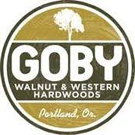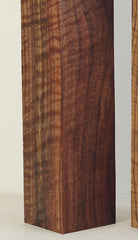
LET'S TALK ABOUT FIGURE
Figured hardwood. Curly maple. Quilt. Spalted, fiddleback, or even flame- if you’ve heard any of these terms before but didn’t know what they meant, keep reading. Today, we’re going to talk about figure.
A board’s figure refers to the ability of the grain in the wood to catch and reflect light. This is a gross oversimplification, but we’ll get to specifics in a minute. First, we need to make sure we’re all on the same page. We all know how wood grain works- trees are basically big bundles of drinking straws, with the grain running along a board’s length. Typically the grain runs straight up and down… but not always. Sometimes the wood grain will veer off a straight path. When a board is cut out of a log, any wood grain that isn’t in the same plane as the saw blade will look like it’s coming out of the board (because it basically is), which gives figure its three-dimensional effect.
“That’s great,” you might say, “but SHOW me, don’t tell me!” Fair enough! Here are some examples of types of figure and what they’re called:
Curl
Curl is comprised of a tight, undulating “ripple” effect in a quarter sawn piece of wood. Whenever you hear about “curly maple”, they’re talking about the figure in the wood, not a new type of maple tree. Curl can be a bit of a catch-all term- for example, all fiddleback is curly, but not all curl can be fiddleback.

Fiddleback
Fiddleback is a very specific type of curl- typically, the spaces in between a curl have to be a quarter of an inch or less for it to be classified as “fiddleback” curl. Tight, uniform, and usually close to a 90 degree angle to the wood grain, fiddleback curl is prized by luthiers for instrument backs and sides. Acoustic guitars, mandolins, and violins are where fiddleback figure can usually be found.
Flame
Flame is another sort of figure that can get caught under the “curly” umbrella, although it’s somewhere between curl and quilt, visually speaking. It looks much like its namesake- almost like the flames of a fire. Electric guitar makers love flame figure for bookmatched tops.

Quilt
Quilt is a pattern that almost looks like bubbling on the surface of the wood. Most often found in big leaf maple, quilted figure is another highly sought-after quality by guitar makers and luthiers; a quilted-top guitar can often double or triple the price of one without.
Crotch
The crotch of a tree is where the main trunk begins to split and branch out. This is an area of high stress inside the trunk, which can result in some beautiful figuring in the wood. Often referred to as “feathering” or “feathercrotch”, the intersection of the grain inside the branch and the trunk combine to create an interference pattern, much like two sets of ripples in a pond.

Spalt
Spalting is somewhat different than the other types of figure we’ve talked about so far. While there’s some debate about what causes wood to become figured, we know what causes spalting- specifically, a fungus. Spalting can happen in almost any wood species, but it’s mostly found in maple. When the ends of a freshly-cut log are exposed to moisture, a fungus can find its way inside the log and begin to eat. If left too long, the fungus will rot the log from the inside out. But if you catch it in time, it will leave random, dark tracks inside the wood that almost look like pen scribbles. Spalted maple is usually stabilized with epoxy resin to counteract the damage done by the fungus that caused it.

Ray Fleck
“Ray Fleck? Never heard of him.” Yeah, very funny. Ray fleck is a quality unique to quartersawn oak, due to oak’s tight grain structure. When an oak log is quarter sawn, the annular rings in an oak log will produce “medullary rays”, more commonly known as “ray fleck”. Ray fleck will usually be at an angle to the wood grain, and look like rays of sunlight spilling across an oak board’s face. Furniture makers are the primary market for this kind of figure, although it’s almost by accident- quarter sawn oak is usually needed for its strength and workability, not necessarily because it’s figured. However, I’ve yet to hear of a woodworker complaining about finding some!
This is by no means a comprehensive list of figured wood; there are many, many other kinds you’ll hear about (bee’s-wing, bear claw, pommele, tiger stripe, etc.) These are just the kinds of figure we run into the most, dealing with hardwoods native to the Pacific Northwest. Other wood species can have different figure unique to them; bear claw is usually only found in softwoods like spruce, while pommele- a mottling similar in looks to quilt- is typically only found in dense equatorial species like sapele.
What causes figure to happen in wood is still up for debate; some say it’s due to a genetic aberration in a particular tree, while others think it’s caused by environmental stress. Whatever the reason, whether you’re making a dining room table or an acoustic guitar- figured woods are a great way to add a bit of visual interest to a project!



